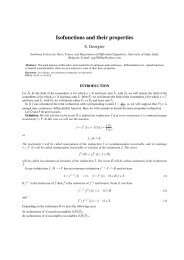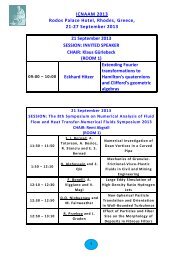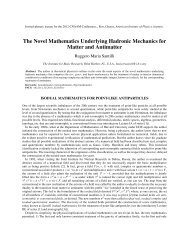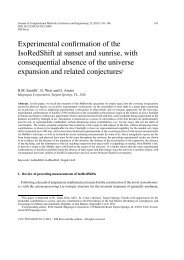A new electronic theory of pericyclic chemistry and aromaticity is ...
A new electronic theory of pericyclic chemistry and aromaticity is ...
A new electronic theory of pericyclic chemistry and aromaticity is ...
You also want an ePaper? Increase the reach of your titles
YUMPU automatically turns print PDFs into web optimized ePapers that Google loves.
162 M.O. Cloonan / International Journal <strong>of</strong> Hydrogen Energy 32 (2007) 159–171C-42'ASIEDC-3C-6DFS1'3'C-1C-2DSIEDAFSFig. 3. The ADEP syn FSED <strong>electronic</strong> mechan<strong>is</strong>m <strong>of</strong> the Diels–Alderconcerted cycloaddition.2.2. The ADEP syn FSED <strong>electronic</strong> mechan<strong>is</strong>m <strong>of</strong> theconcerted cycloadditionApplying the ADEP concept to the concerted Diels–Alder[4 + 2] reaction results in the <strong>electronic</strong> mechan<strong>is</strong>m illustratedin Fig. 3 (view the dienophile, C2 = C1, as lying below theplane <strong>of</strong> the diene). The double bonds <strong>of</strong> butadiene are assumedto be localized (see subsequent paper). Based on the logic <strong>of</strong>the assumption the olefin ‘initiates’ the cycloaddition by actingas a nucleophile or <strong>is</strong>oelectron source. Th<strong>is</strong> will be referredto as the 1 ′ process <strong>and</strong> the nucleophilic center, C-1, as theDSIED (donor site <strong>of</strong> initial electron dynamics). The diene actsas the electrophile in the 1 ′ process <strong>and</strong> the center, C-3, willbe referred to as the ASIED (acceptor site <strong>of</strong> initial electrondynamics). The 1 ′ process results in an increase in electrondensity on the face <strong>of</strong> C-4 that points away from the dienophile(olefin) due to the antiperiplanar dynamics <strong>of</strong> the <strong>is</strong>oelectronpairs (ADEP). Th<strong>is</strong> increase in electron density at C-4 actsas a nucleophilic center <strong>and</strong> attacks the C5–C6 double bond.Th<strong>is</strong> ADEP process results in an increase in electron densityon the face <strong>of</strong> C-6 that points towards the dienophile. Thusthe decrease in electron density at C-2 <strong>of</strong> the dienophile, dueto the 1 ′ process, can be neutralized rapidly by the increasein electron density at C-6 because the electron density at C-6 <strong>is</strong> pointing directly towards the top face <strong>of</strong> C-2. Th<strong>is</strong> facialaspect <strong>of</strong> the electron flow at the C-6 <strong>and</strong> C-2 terminus willbe referred to as the FSED (final facial selectivity <strong>of</strong> electrondensity). In th<strong>is</strong> case the increase in electron density at C-6 <strong>and</strong>the decrease in electron density at C-2 occur on the faces <strong>of</strong>the atoms that point towards each other. Th<strong>is</strong> will be referredto as ‘syn FSED’. It <strong>is</strong> th<strong>is</strong> syn FSED concept that expoundswhy the reaction <strong>is</strong> concerted. It prevents charge accumulation.Charged species are in general far less stable than the neutralspecies. Thus developing charge increases the activation energy<strong>and</strong> minimizing the degree <strong>of</strong> charge results in pathways <strong>of</strong>relatively low activation energy. A concerted reaction, basedon th<strong>is</strong> <strong>new</strong> <strong>electronic</strong> <strong>theory</strong>, <strong>is</strong> proposed to involve an ADEPprocess with syn FSED. To illustrate electron density movingon the bottom face <strong>of</strong> the molecule a dashed curved arrow <strong>is</strong>used arbitrarily <strong>and</strong> a plain curved arrow for dynamics on thetop face. In the 1 ′ process electron density moves above theplane <strong>of</strong> the dienophile, as drawn, <strong>and</strong> thus a plain curved arrow<strong>is</strong> invoked. In the 3 ′ process electron density moves below theplane <strong>of</strong> the diene <strong>and</strong> thus a dashed curved arrow <strong>is</strong> used. Theplane <strong>of</strong> the electron source <strong>is</strong> arbitrarily considered as opposedto the electron sink. As in the Robinson electron <strong>theory</strong> thecurved arrows imply the movement <strong>of</strong> electrons only <strong>and</strong> notthe nuclei. C-6 <strong>of</strong> the diene will be referred to as the DFS (donorat the final facial selectivity site) <strong>and</strong> C-2 <strong>of</strong> the dienophile asthe AFS (acceptor at the final facial selectivity site).Within the logic <strong>of</strong> th<strong>is</strong> <strong>theory</strong> the movement <strong>of</strong> electron density<strong>is</strong> also a gradual process, which prevents charge accumulation,i.e. no site develops a full negative or position chargeat any stage in the reaction. The 2 ′ process has begun beforethe 1 ′ process <strong>is</strong> complete <strong>and</strong> the 3 ′ process has begun beforethe 2 ′ process <strong>is</strong> complete. As no charge accumulates, solventpolarity has little effect on the rate <strong>of</strong> cycloaddition as <strong>is</strong> foundexperimentally. In conjunction with the experimental data onwhich the assumptions <strong>of</strong> th<strong>is</strong> <strong>theory</strong> are deduced from, theADEP mechan<strong>is</strong>m for thermal <strong>pericyclic</strong> reactions <strong>is</strong> predictedto be favoured over the SDSE <strong>and</strong> SDEP as d<strong>is</strong>cussed above(Section 2.1).Based on th<strong>is</strong> <strong>electronic</strong> mechan<strong>is</strong>m the majority <strong>of</strong> the activationenergy in relation to the contribution from the <strong>electronic</strong>mechan<strong>is</strong>m (there <strong>is</strong> also a thermodynamic contribution to thetransition state from the exothermic reaction) <strong>is</strong> predicted to beinvolved in the 1 ′ process. Th<strong>is</strong> <strong>is</strong> because, once the <strong>is</strong>oelectronsbegin to move the process begins to drive itself, as electrondensity moves towards a region <strong>of</strong> low electron density (AFS).Within the ADEP syn FSED <strong>theory</strong> the transition state <strong>is</strong> asynchronousby definition (see Section 2.3 on KIE’s <strong>and</strong> Section2.4 for empirical evidence). Th<strong>is</strong> prediction <strong>is</strong> different fromthe predictions <strong>of</strong> the present quantum chemical methods. Bondmaking at the DSIED-ASIED terminus <strong>is</strong> always in advance <strong>of</strong>bond making at the DFS–AFS terminus (syn FSED cannot beachieved otherw<strong>is</strong>e), including the parent Diels–Alder.Based on the ADEP assumption the dienophile must behaveas the DSIED for a concerted reaction to occur. In a reactionpathway in which the diene behaves as the DSIED (C-3), theFSED at C-2 <strong>and</strong> C-6 <strong>is</strong> not syn. The increase in electron densityat C-2 <strong>of</strong> the dienophile occurs on the face pointing away fromthe diene <strong>and</strong> thus <strong>is</strong> unable to neutralize the decrease in electrondensity on the diene <strong>and</strong> thus charge begins to build up. Th<strong>is</strong>‘trans FSED’ cannot result in a concerted process <strong>and</strong> such aninteraction <strong>is</strong> predicted to involve a stepw<strong>is</strong>e pathway.The behaviour <strong>of</strong> the dienophile as an electron donor in the1 ′ process <strong>and</strong> subsequently as an electron acceptor in the 3 ′process, in the proposed concerted mechan<strong>is</strong>m, <strong>and</strong> the orderin which they occur <strong>is</strong> similar to an electrophilic addition toa multiple bond, but without full charges or an intermediatedeveloping. As the 1 ′ process <strong>is</strong> predicted to be the slowestpart in the overall <strong>electronic</strong> mechan<strong>is</strong>m it <strong>is</strong> essentially anA-SE2 type mechan<strong>is</strong>m [14]. Cons<strong>is</strong>tent with th<strong>is</strong> <strong>new</strong> <strong>electronic</strong>mechan<strong>is</strong>m <strong>of</strong> <strong>pericyclic</strong> reactions the A-SE2 mechan<strong>is</strong>minvolving multiple bonds (no bridging intermediate possible asH involved) <strong>is</strong> highly stereospecific <strong>and</strong> syn, syn <strong>is</strong> increasinglyfavoured at low temperatures <strong>and</strong> by weakly donating solventsas well as by increasing the concentration <strong>of</strong> HX [15]. Thusnot only <strong>is</strong> a facial aspect to the decrease in electron densityat the AFS possible but it <strong>is</strong> syn to the DSIED based on the







